No matter how often you Google “How to cure TMJ?” you will not get a perfect answer. This is because TMJ cannot be completely cured. It can be managed.
Namaste Everyone! As a dentist, I see many people (especially women) who have TMD (Temporomandibular Disorders) and are looking for a permanent cure. Although medical science has progressed a lot, there are some parts/diseases about which we don’t have a satisfactory answer. TMD is one of them.
We cannot cure it, but make it bearable for you. So, in this blog, I want to discuss what works and what does not work in treating TMJ (temporomandibular joint )
You might be confused by our use of the terms TMJ and TMD. Let me clarify: “TMDs” refer to disorders, and “TMJ” refers only to the temporomandibular joint itself.
Temporomandibular disorders (TMDs) refer to a group of over thirty conditions that lead to pain and problems with the jaw joint and the muscles responsible for jaw movement.
So, what exactly is TMJ, and why does it cause so much trouble? TMJ is the temporomandibular joint, the hinge-like joint connecting your jawbone to your skull.
It’s the reason you can talk, chew, and yawn comfortably—when everything’s working as it should. But when things go off track, it can lead to what we call Temporomandibular Joint Disorder, or TMD.
TMJ Disorder isn’t just jaw pain; it’s a range of symptoms that can include things like muscle tension, clicking or popping sounds when you open your mouth, and even headaches or ear pain. Some people feel it as a dull ache, while others experience sharp pain or discomfort that can make daily tasks—like eating or speaking—a real challenge. The thing about TMD is that it doesn’t always present the same way for everyone, and it can vary from mild to severe, even day by day.

You’re probably wondering, “Why did I suddenly get TMJ?” The truth is, there isn’t always a clear-cut answer, and there can be several factors at play. Here are a few common causes:
You might be wondering if TMJ is serious. Or is TMJ a lifelong problem? The answer is that it really depends. For some, TMJ symptoms come and go with minor discomfort.
However, for others, it can become a chronic issue that needs consistent management. While TMJ isn’t life-threatening, it can significantly impact your quality of life, affecting everything from how you eat to how you sleep.
The good news? Many people find relief and regain control over their symptoms with the right approach.
So, if you’re feeling worried about your jaw pain, you’re not alone, and there are ways to manage it. Let’s explore some of those options next.
If you’re living with TMJ discomfort, you might be surprised to learn that a few simple lifestyle tweaks can make a noticeable difference. Sometimes, it’s about taking the pressure off your jaw in ways you might not expect. Let’s look at some practical steps to help manage TMJ symptoms in your daily life.
Did you know that what you eat can actually impact your jaw pain? Certain foods can strain your jaw muscles and make things worse if you have TMJ.
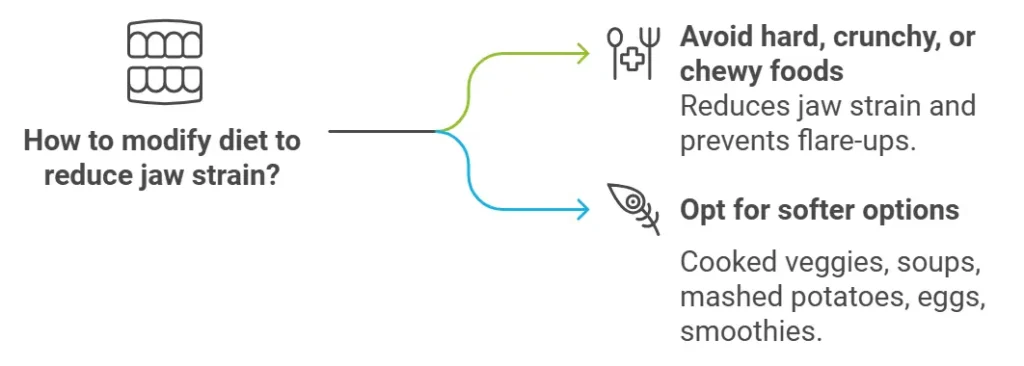



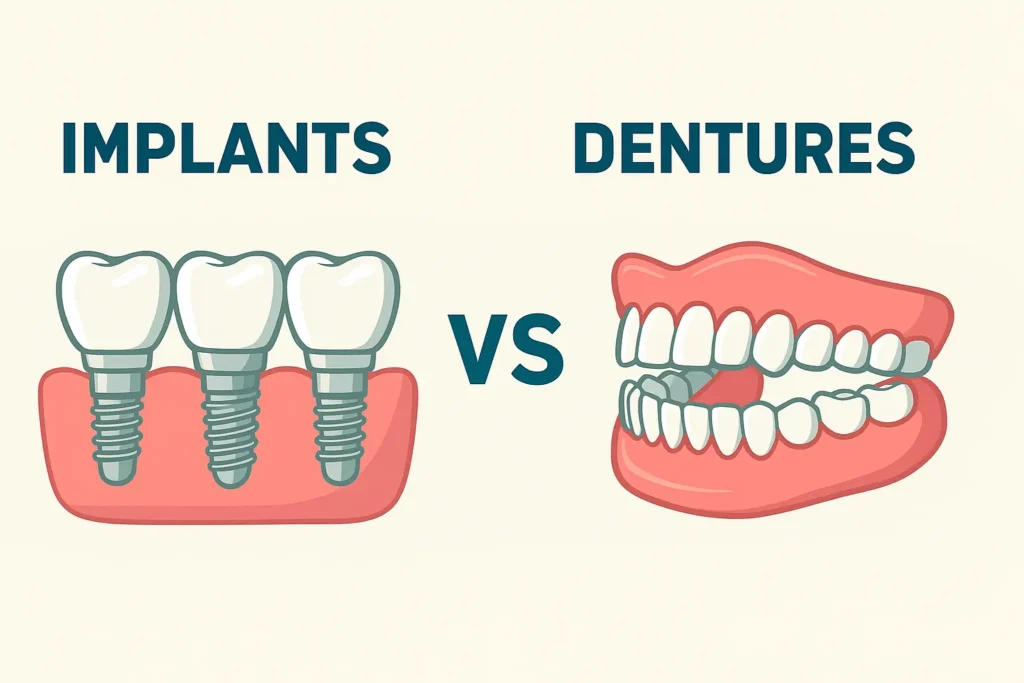
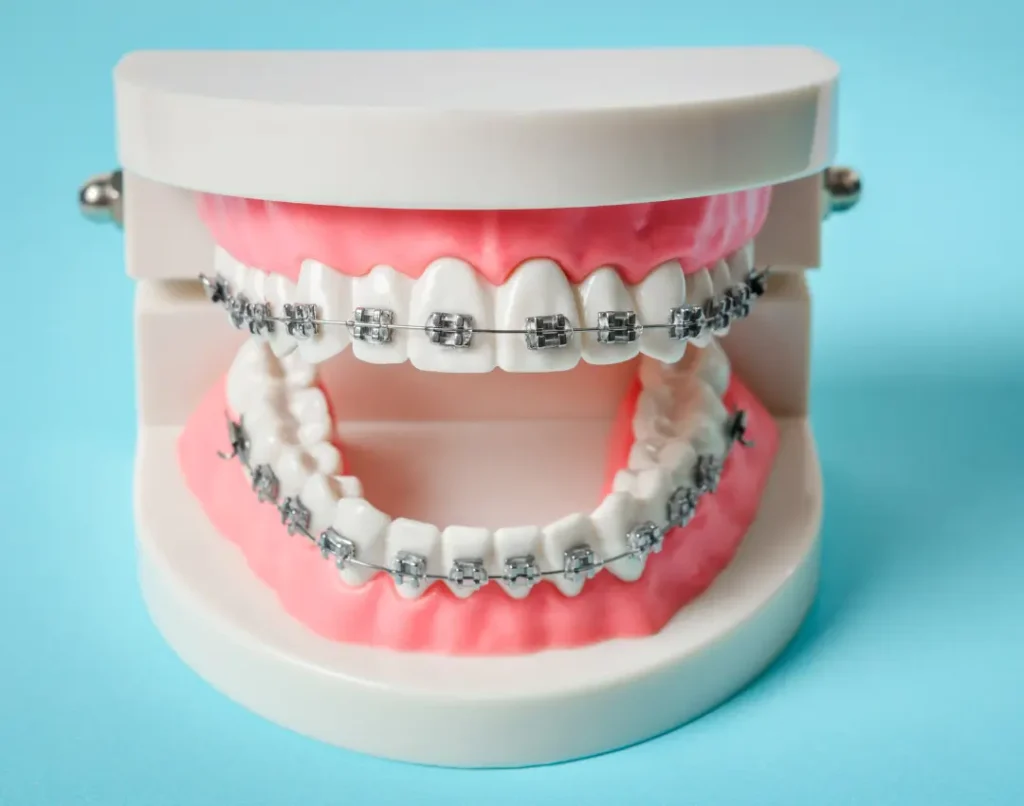
Hard, crunchy, or chewy foods force your jaw to work harder, increasing pain and tension. So, what should you avoid eating if you have TMJ?
It’s best to steer clear of nuts, raw vegetables, tough meats, and chewy candies. Instead, opt for softer foods that are easier on the jaw, like cooked vegetables, soups, mashed potatoes, eggs, and smoothies.
Choosing a TMJ-friendly diet doesn’t mean you have to eat bland or boring foods, but giving your jaw some relief through softer options can prevent flare-ups and help you manage symptoms in the long run.
Have you ever noticed how your jaw tightens when you’re stressed? Stress is a major contributor to TMJ pain because it often leads to clenching and grinding—sometimes without you even realizing it.
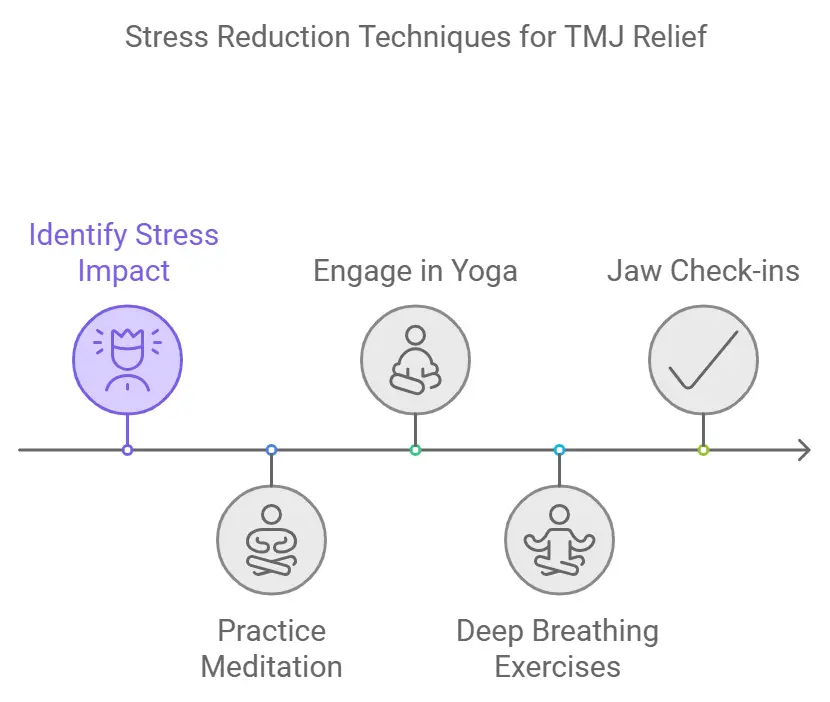
Can TMJ come from stress? Absolutely. The tension builds up in the jaw, shoulders, and neck, making TMJ symptoms worse.
To help relax your jaw, consider trying stress-relieving activities like meditation, yoga, or deep breathing exercises.
Even a few minutes of mindful breathing can help release tension. You might also want to build in “jaw check-ins” throughout the day—just take a moment to unclench, relax your shoulders, and let your jaw drop. These small practices can reduce the strain on your TMJ over time.
If your jaw feels tight or stiff, gentle exercises might be just what you need. Many TMJ specialists recommend exercises that can help increase flexibility and reduce tension in the jaw area.

So, what’s the best exercise for TMJ? Here’s a simple one: place your tongue on the roof of your mouth, then slowly open and close your mouth. This exercise helps control the range of motion and keeps your jaw from opening too wide.
For those wondering, “How can I fix my TMJ myself?” These exercises can be a great place to begin. Simple stretches and controlled movements, when done consistently, can lead to improvements in flexibility and a reduction in discomfort. Start gently and build up gradually.
Did you know your sleeping position can actually impact TMJ pain? How should you sleep with TMJ? It’s best to avoid sleeping on your stomach, as this can put extra pressure on the jaw and neck. Instead, try to sleep on your back or side, ideally with a supportive pillow that aligns your neck and jaw properly.
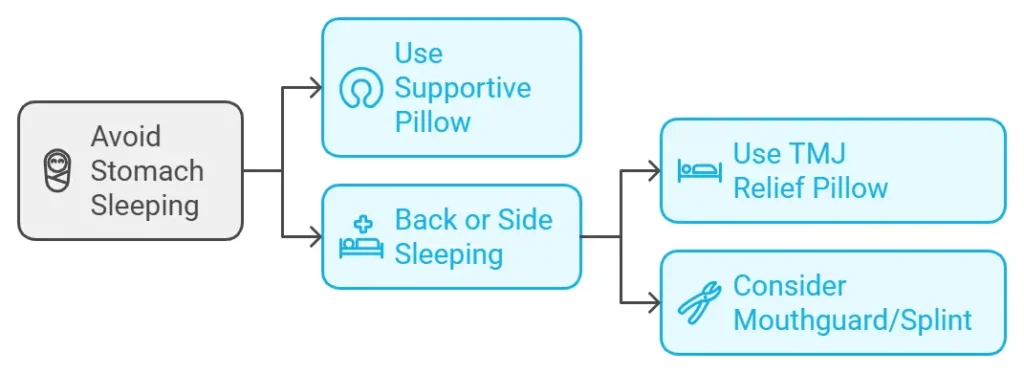
Some people find that using a pillow specifically designed for TMJ relief can also help by minimizing the strain on the jaw muscles overnight.
If you’re experiencing more pain at night, you’re not alone. Is TMJ worse at night? For many, yes. It’s common to clench or grind your teeth while sleeping, aggravating TMJ symptoms.
Some people wear a custom mouthguard or splint at night to help prevent grinding. The guard keeps the jaw relaxed and prevents grinding.
These lifestyle adjustments aren’t overnight fixes but can offer some solid relief over time. Combined with professional guidance, these daily habits can make managing TMJ much more doable.
Ready to dive into more treatment options? Let’s explore some professional therapies next.
For most people with TMJ, lifestyle changes and professional therapies can manage symptoms effectively. But in some cases, when pain and dysfunction persist despite trying every non-surgical option, surgery may be worth considering.
Surgery is generally a last resort, reserved for severe cases where other treatments haven’t provided enough relief.
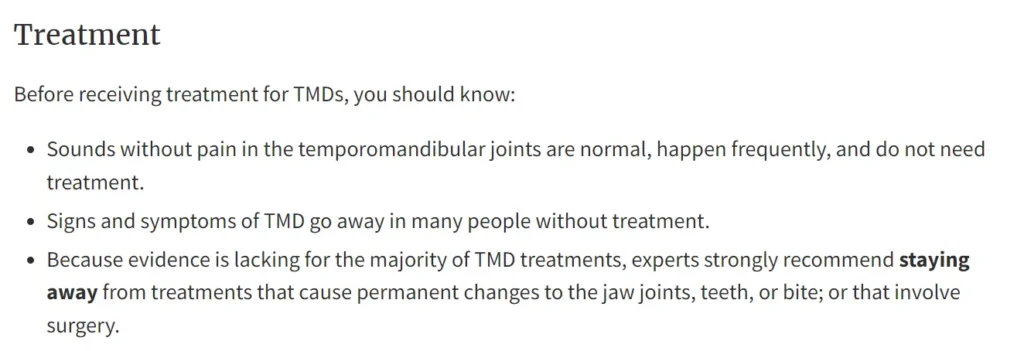
So, what is the last stage of TMJ? While TMJ isn’t always progressive, certain severe cases can involve structural damage or ongoing joint issues that simply don’t respond to conservative treatments.
If you’ve tried everything else—splints, physical therapy, medication, stress management—and you’re still in significant pain or unable to move your jaw properly, surgery might be the next step.
However, this decision should always be made carefully, in consultation with a TMJ specialist who can evaluate your unique situation.
Like any surgery, there’s likely to be some discomfort involved. However, pain management techniques have advanced significantly, and most people find that post-surgery discomfort is manageable, especially with the support of a knowledgeable healthcare team.
For many, the potential relief from chronic pain is worth the temporary discomfort of surgery.
If you’re considering surgery, knowing what options are available is helpful. Here are a few of the common surgical approaches for TMJ:
If you’re considering TMJ surgery, setting realistic expectations is essential. Surgery is not a guaranteed “cure-all” for TMJ, but for those who truly need it, it can provide substantial, lasting relief.
After surgery, most people experience reduced pain, improved jaw function, and an enhanced quality of life. Recovery times vary depending on the procedure, but minimally invasive options like arthroscopy and arthrocentesis typically have shorter recovery periods.
Conversely, open joint surgery may require more healing time and physical therapy to regain full function.
While there’s no guarantee of a perfect outcome, many patients find that surgery gives them a new lease on life, allowing them to return to activities they once avoided due to pain.
Surgery is a big decision, but for those with severe, persistent TMJ, it can be the key to reclaiming comfort and mobility.
In the next section, let’s discuss additional long-term management strategies to keep those gains steady after surgery.
Managing TMJ isn’t just about finding relief once—it’s about staying mindful of the little things that keep your jaw in good shape over the long haul.
For many people, sticking to a few helpful habits can make all the difference between regular flare-ups and living mostly pain-free.
Here are some tips to help you keep TMJ symptoms under control and support your jaw health for the long term.
One of the biggest culprits behind TMJ discomfort? Stress. When we’re stressed, it’s easy to clench or grind our teeth without even realizing it, which puts extra strain on the jaw.
By building regular stress-relief practices into your routine, you can give your jaw a much-needed break. Consider activities like meditation, deep breathing exercises, yoga, or even a quick walk outdoors to unwind.
Consistently managing stress can prevent that unconscious jaw clenching and keep TMJ discomfort at bay.
A soft-food diet can be your best friend when your TMJ symptoms flare up. Foods like smoothies, soups, mashed vegetables, and eggs can be easier on your jaw, reducing the strain during painful episodes.
But don’t just think of this as a temporary solution—keeping soft foods as a regular part of your diet, especially when symptoms worsen, can make a big difference.
And let’s not forget jaw exercises! Gentle, regular exercises can help maintain flexibility and relieve muscle tension.
Even after your symptoms have improved, it’s a good idea to keep up with these exercises. Think of them as maintenance for your jaw muscles—just like stretching helps prevent stiffness in other body parts.
Regular check-ins with a TMJ specialist are important, even if your symptoms seem manageable. TMJ can sometimes escalate without much warning, so having a professional monitor, your progress can catch any early signs of worsening.
Your specialist can adjust your treatment plan and help keep your symptoms from returning to full force. Consistent support can be a game-changer if you’re in it for long.
We all have little habits that can make TMJ worse, even if we don’t mean to. So, what are TMJ’s bad habits?
Things like nail-biting, chewing gum, clenching your jaw, or even leaning on your chin with your hand can put extra pressure on the jaw.
These might seem harmless, but over time, they can add up and exacerbate TMJ symptoms. Being mindful of and avoiding these habits can help relax your jaw.
Managing TMJ isn’t about doing one thing; it’s about building a lifestyle that supports jaw health. With these habits in place, you’ll have a solid foundation for keeping TMJ discomfort in check.
Next, let’s look at some frequently asked questions about TMJ for even more insights.
TMJ disorders can improve over time, especially with proper care, but whether it fully heals varies from person to person. Some people experience complete relief, while others manage symptoms long-term. Consistent treatment and lifestyle changes increase the chances of significant improvement.
Yes, many people find that their TMJ symptoms reduce or even disappear with appropriate treatment and self-care. By addressing underlying causes like stress or misalignment and following a tailored treatment plan, your jaw function can return to normal.
While there isn’t a one-size-fits-all cure for TMJ disorders, they are often manageable. A combination of treatments—such as physical therapy, stress management, and dental interventions—can effectively control symptoms and improve quality of life.
In some cases, TMJ symptoms can lessen or resolve on their own with natural self-care methods. These include stress reduction techniques, jaw exercises, and avoiding hard or chewy foods. However, persistent symptoms should be evaluated by a professional.
If left untreated, TMJ disorders can lead to chronic pain, increased joint damage, and difficulties with eating or speaking. Over time, this can significantly impact daily life and may require more intensive treatments.
You can manage mild TMJ symptoms at home by:
For persistent issues, it’s important to consult a healthcare professional.
While TMJ disorders aren’t life-threatening, they can significantly affect your quality of life. Chronic pain, difficulty eating, and sleep disturbances are common. Seeking treatment can help manage these symptoms effectively.
To relax your jaw muscles:
One effective exercise is the Resisted Opening:
This helps strengthen and stretch the jaw muscles.
Absolutely! Stress often leads to muscle tension, clenching, and teeth grinding—all of which can contribute to TMJ disorders. Managing stress through relaxation techniques can help alleviate symptoms.
Avoid foods that strain your jaw, such as:
Opt for softer foods to ease jaw discomfort.
Creating a relaxing bedtime routine can also help minimize clenching at night.
In some cases, orthodontic treatments like braces can help if TMJ issues stem from misaligned teeth or an improper bite. Aligning the teeth can reduce stress on the jaw joint. However, braces aren’t a guaranteed fix for TMJ disorders.
The most effective treatment often involves a combination of:
Consulting with a TMJ specialist can tailor the best approach for you.
TMJ disorders can develop due to:
Identifying the cause can help in choosing the right treatment.
The duration varies:
Early intervention and consistent treatment can reduce the duration and severity of symptoms.
Living with TMJ can be challenging, but there are so many ways to take control and find relief. From making small lifestyle adjustments—like eating softer foods and practicing stress management—to exploring professional treatments and, in rare cases, surgery, every step can help ease symptoms and improve your quality of life. While TMJ may not have a simple “cure,” it can be managed effectively with a personalized approach.
If you’re dealing with ongoing TMJ pain or discomfort, don’t hesitate to reach out to a specialist who can help tailor a treatment plan to your needs.
With the right combination of self-care, professional support, and consistent efforts, long-term relief is absolutely possible. You’re not alone in this journey, and a pain-free life could be within reach with the right approach.




